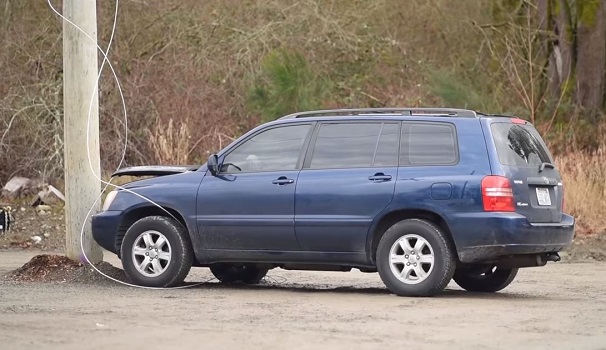When a power line has gone down and is over or near your car, you should always assume the wire within the power line is still live or “energized.” Even if you can’t see smoke, arcs, or sparks coming from the power line, it may still be energized. Even with downed lines that have low voltage, from 120 to 130 volts, there’s still enough amperage and enough voltage to give you a lot of trouble as any high voltage line could. The real danger occurs when you step out from your car—setting one foot onto the ground while the other remains in the vehicle causes you to complete a circuit and then get electrocuted or shocked. This is called “touch potential.”
In another instance, you might step out from your vehicle and start walking from the downed line to a safer distance. It’s when you separate your legs while walking that you complete a circuit, causing you to be electrocuted or shocked (“step potential,” as it’s called). No doubt, this is a serious situation to find yourself in, so what should you do in order to keep from being killed when there’s a downed power line over or near your car?
In the two previously-mentioned scenarios of step or touch potential, you’re shocked or killed because the electricity wants to ground itself from the closest conductor to the energizing downed line. In either scenario, the vehicle is energized, but its rubber tires are acting as insulators, which safely ground the electricity. However, an entire 30- to 35-foot circle around the car is also energized, with the downed power line creating a ripple of energy at that length.
While this may seem like a no-win scenario, there are ways of protecting yourself, including the following steps below:
- Remain in your vehicle until the utility or power company de-energizes the power line, and don’t get out till the utility or power company says that it’s safe to do so.
- However, if smoke becomes visible inside the car, and staying is no longer an option, then before you wind up hospitalized or dead from burns or smoke inhalation, remember the dangers of touch and step potential electrocutions.
- To avoid such dangers, jump from the car with both of your feet off the car first prior to landing on the ground. Make sure you land using both of your feet, but do not stumble—you could fall and get electrocuted. Bend your knees after jumping for better balance to avoid stumbling. Be sure to not touch the car after jumping.
- After successfully jumping, you need to use small, toe-to-heel steps without separating your legs or feet, moving roughly 30 feet away from your vehicle before you can separate your feet. If you start feeling tingling sensations in your feet while attempting to separate them, you may still be at risk, so walk another five feet to give yourself more clearance from step and touch potential shocks. Once you pass 35 feet, it should be safe for separating your feet, but avoid entering the energized zone until the power is shut off before going back to your vehicle.
- Another option you have—after jumping from your vehicle with both your feet onto the ground—is bunny hopping with your legs and feet together, jumping using only small leaps, as leaping too far might result in you falling, separating your legs and toes, and getting shocked. Again, clear 30 feet at least, but if your legs start tingling, hop another five feet.
Remember, if you’ve cleared your vehicle, and it is on fire, walk away from it normally so that if it blows up, you at least won’t have shrapnel flying at you while you’re scrambling away. If your vehicle is on fire or smoking, call 911 as soon as you can.
Photo via Puget Sound Energy Youtube Video (featured in the article)

